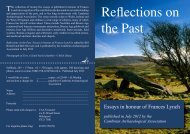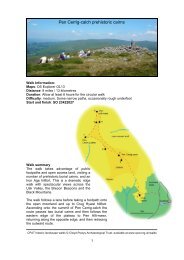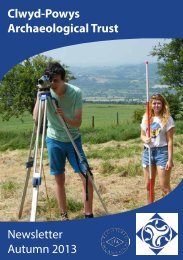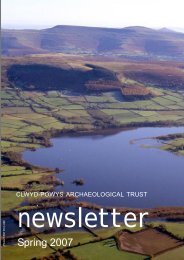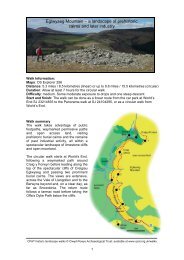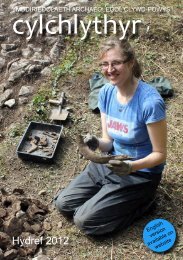Datganiad Cadwraeth Clawdd Offa Offa's Dyke Conservation ...
Datganiad Cadwraeth Clawdd Offa Offa's Dyke Conservation ...
Datganiad Cadwraeth Clawdd Offa Offa's Dyke Conservation ...
You also want an ePaper? Increase the reach of your titles
YUMPU automatically turns print PDFs into web optimized ePapers that Google loves.
28 <strong>Datganiad</strong> <strong>Cadwraeth</strong> <strong>Clawdd</strong> <strong>Offa</strong><strong>Offa</strong>'s <strong>Dyke</strong> <strong>Conservation</strong> Statement 28<strong>Clawdd</strong> <strong>Offa</strong> yn nhirwedd heddiw5.5 Yr hyn sy’n amlwg o’r corff hwn o ymchwil ddiweddaryw, tra bo <strong>Clawdd</strong> <strong>Offa</strong> wastad wedi bod yn rhan o dirweddsy’n datblygu mewn modd sydd, yn anochel, wedi arwain atryw gymaint o ddifrod parhaus iddo, mae’r henebyn heddiw —ar y cyd â nifer o elfennau eraill yr amgylchfyd hanesyddol —yn wynebu mwy o bwysau ar ei oroesiad hirdymor nag erioedo’r blaen.5.6 Mae’r sefyllfa hon yn achosi pryder arbennig, yn amloherwydd bod effaith gronnol colledion blaenorol wedi dod â’rclawdd i drothwy critigol lle mae ei gymeriad craidd a’i integreddfel nodwedd unionlin ystyrlon a gweledol eisoes wedi ei beryglui bwynt lle na ellir ymdopi â dirywiad pellach yn hawdd.5.7 Mae dirywiad y clawdd yn gyffredinol yn deillio o ystodo achosion penodol; y prif bwnc ar hyn o bryd ywgweithgaredd amaethyddol yn arwain at erydu ar 34% o’rclawdd yng Nghymru (Burnham 1992). Mae problemau eraill anodwyd yng Nghymru — erydiad llwybrau (4%), rheolicoetiroedd (6%), tyrchu (2%) a datblygiad (8%) yn ymddangosyn llai arwyddocaol o ran canran y clawdd yr effeithir arno, ondyn amlwg gall fod yn ddifrifol iawn mewn cyd-destun lleol, fel ymae achos Swydd Gaerloyw yn dangos yn glir (Hoyle aVallender 1997) ac fel y mae arolwg a gysylltwyd yn benodol âLlwybr <strong>Clawdd</strong> <strong>Offa</strong> hefyd wedi dangos (Cutts 1998).<strong>Offa</strong>’s <strong>Dyke</strong> in today’s landscape5.5 What is evident through this body of recent research isthat, while <strong>Offa</strong>’s <strong>Dyke</strong> has always been part of an evolvinglandscape in a way which has inevitably resulted in a certainamount of ongoing damage to it, the monument today — incommon with many other components of the historicenvironment — faces greater pressures on its long termsurvival than ever before.5.6 This situation is particularly worrying simply because thecumulative effect of previous loss has brought the dyke to acritical threshold where its core character and integrity as acoherent and visible linear feature is already compromised tothe point where further degradation cannot be lightly absorbed.5.7 The general deterioration of the dyke is the result of arange of specific causes; the principal identified issue at thepresent time is agricultural activity resulting in erosion on 34%of the dyke in Wales (Burnham 1992). Other problems noted inWales — path erosion (4%), woodland management (6%),burrowing (2%) and development (8%) appear less significantin terms of the percentage amount of dyke affected, but canclearly be very serious in local circumstances, as theGloucestershire case in particular demonstrates (Hoyle andVallender 1997) and as survey linked specifically to the <strong>Offa</strong>’s<strong>Dyke</strong> Path has also shown (Cutts 1998).Rheoli glaswelltir5.8 Mae gorbori yn beth cyffredin iawn ar Glawdd <strong>Offa</strong>, ynarwain at golli gwair ar rannau o’r gwrthglawdd, ac yna erydiadgweithredol ac, yn nodweddiadol iawn, tyllau y mae anifeiliaidyn eu ffurfio sy’n gallu tyfu i faint difrifol.5.9 Gall difrod ‘pori’, mewn gwirionedd, adlewyrchu patrwmcymhleth o achosion. Mae’r rhain yn cynnwys effaith sychder ary clawdd, cysgod coed neu brysgwydd a chywasgiad a achosirgan draed anifeiliaid. Rhan o’r broblem yw tuedd naturiolanifeiliaid i ymgasglu ar y clawdd (sy’n cynnig llwybr sych ardraws caeau a lle da i gysgodi) sydd o ganlyniad yn creu lefelauuwch o weithgaredd anifeiliaid ar y gwrthglawdd nag a fyddailefelau ymddangosiadol stocio caeau yn ei awgrymu.5.10 Gall patrymau pori penodol — er enghraifft gaeafuanifeiliaid (gwartheg yn enwedig) — waethygu erydiad, ac maehefyd yn amlwg bod amodau hinsawdd eithafol weithiau ynysgogiad penodol ar gyfer dirywiad glaswellt sy’n datblygu amy tro cyntaf (Berry 2000). Gall ffactorau eraill, megis dodimannau bwydo neu ffynonellau d@r ar y clawdd,ganolbwyntio pwysau anifeiliaid domestig ar y gwrthglawdd.Grassland management issues5.8 Over-grazing is a common issue on <strong>Offa</strong>’s <strong>Dyke</strong>, resultingin loss of grass cover on areas of the earthwork followed byactive erosion and very typically the formation of animalscrapes which can reach serious proportions.5.9 ‘Grazing’ damage may in fact reflect a complex pattern ofcauses. These include drought effects on the dyke bank,shading by trees or scrub and compaction caused by animaltrampling. Part of the problem is the natural tendency ofanimals to congregate on the dyke (which typically affords adry cross field path and a good place to shelter) consequentlycreating higher levels of animal activity on the earthwork thanapparent field stocking levels might suggest would be the case.5.10 Particular patterns of grazing — for example overwinteringof animals (especially cattle) — can increase theseverity of erosion, and it is also evident that extreme climaticconditions are sometimes a specific trigger for swarddeterioration to first develop (Berry 2000). Other factors, suchas placing feeding stations or water sources on the dyke, canfurther concentrate domestic animal pressure on the earthwork.



